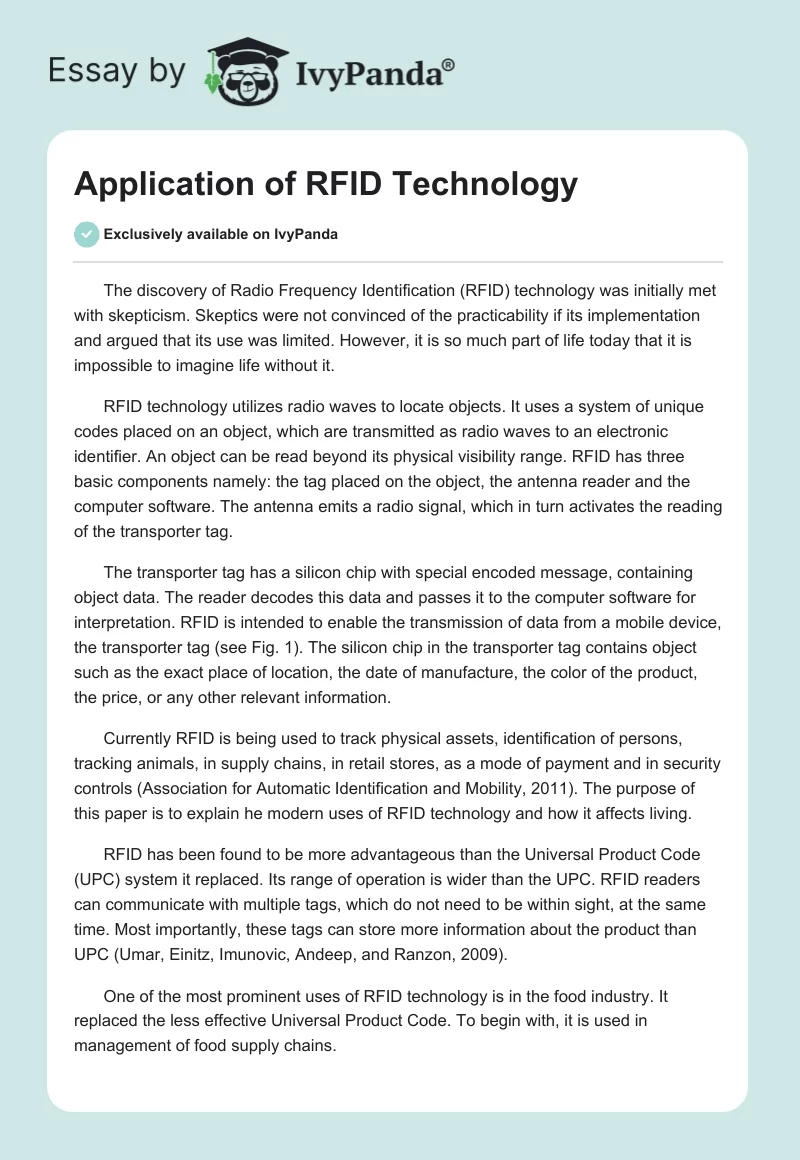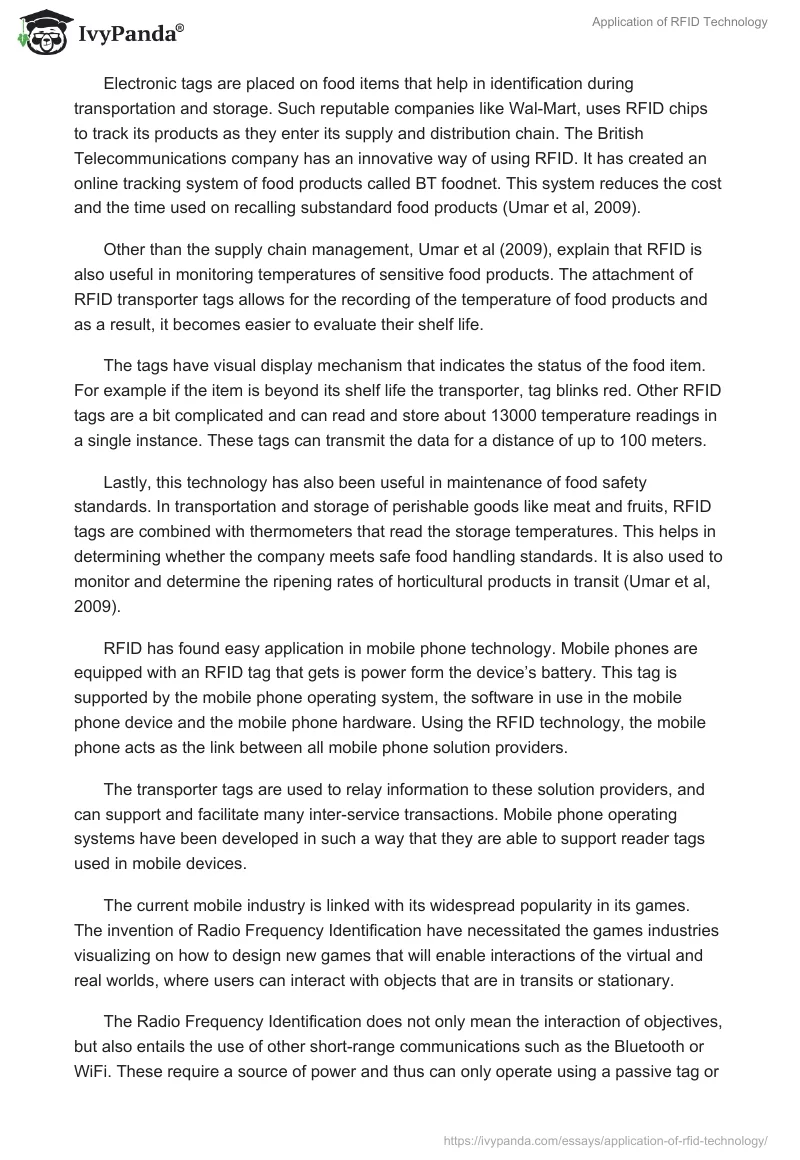The discovery of Radio Frequency Identification (RFID) technology was initially met with skepticism. Skeptics were not convinced of the practicability if its implementation and argued that its use was limited. However, it is so much part of life today that it is impossible to imagine life without it.
RFID technology utilizes radio waves to locate objects. It uses a system of unique codes placed on an object, which are transmitted as radio waves to an electronic identifier. An object can be read beyond its physical visibility range. RFID has three basic components namely: the tag placed on the object, the antenna reader and the computer software. The antenna emits a radio signal, which in turn activates the reading of the transporter tag.
The transporter tag has a silicon chip with special encoded message, containing object data. The reader decodes this data and passes it to the computer software for interpretation. RFID is intended to enable the transmission of data from a mobile device, the transporter tag (see Fig. 1). The silicon chip in the transporter tag contains object such as the exact place of location, the date of manufacture, the color of the product, the price, or any other relevant information.
Currently RFID is being used to track physical assets, identification of persons, tracking animals, in supply chains, in retail stores, as a mode of payment and in security controls (Association for Automatic Identification and Mobility, 2011). The purpose of this paper is to explain he modern uses of RFID technology and how it affects living.
RFID has been found to be more advantageous than the Universal Product Code (UPC) system it replaced. Its range of operation is wider than the UPC. RFID readers can communicate with multiple tags, which do not need to be within sight, at the same time. Most importantly, these tags can store more information about the product than UPC (Umar, Einitz, Imunovic, Andeep, and Ranzon, 2009).
One of the most prominent uses of RFID technology is in the food industry. It replaced the less effective Universal Product Code. To begin with, it is used in management of food supply chains.
Electronic tags are placed on food items that help in identification during transportation and storage. Such reputable companies like Wal-Mart, uses RFID chips to track its products as they enter its supply and distribution chain. The British Telecommunications company has an innovative way of using RFID. It has created an online tracking system of food products called BT foodnet. This system reduces the cost and the time used on recalling substandard food products (Umar et al, 2009).
Other than the supply chain management, Umar et al (2009), explain that RFID is also useful in monitoring temperatures of sensitive food products. The attachment of RFID transporter tags allows for the recording of the temperature of food products and as a result, it becomes easier to evaluate their shelf life.
The tags have visual display mechanism that indicates the status of the food item. For example if the item is beyond its shelf life the transporter, tag blinks red. Other RFID tags are a bit complicated and can read and store about 13000 temperature readings in a single instance. These tags can transmit the data for a distance of up to 100 meters.
Lastly, this technology has also been useful in maintenance of food safety standards. In transportation and storage of perishable goods like meat and fruits, RFID tags are combined with thermometers that read the storage temperatures. This helps in determining whether the company meets safe food handling standards. It is also used to monitor and determine the ripening rates of horticultural products in transit (Umar et al, 2009).
RFID has found easy application in mobile phone technology. Mobile phones are equipped with an RFID tag that gets is power form the device’s battery. This tag is supported by the mobile phone operating system, the software in use in the mobile phone device and the mobile phone hardware. Using the RFID technology, the mobile phone acts as the link between all mobile phone solution providers.
The transporter tags are used to relay information to these solution providers, and can support and facilitate many inter-service transactions. Mobile phone operating systems have been developed in such a way that they are able to support reader tags used in mobile devices.
The current mobile industry is linked with its widespread popularity in its games. The invention of Radio Frequency Identification have necessitated the games industries visualizing on how to design new games that will enable interactions of the virtual and real worlds, where users can interact with objects that are in transits or stationary.
The Radio Frequency Identification does not only mean the interaction of objectives, but also entails the use of other short-range communications such as the Bluetooth or WiFi. These require a source of power and thus can only operate using a passive tag or barcode. Formerly cell phones had an on board camera to decode the code on the camera or from an online database.
Thus, the existence of Radio Frequency Identification offers an alternative faster solution in mobile games and cameras as their tags can be accessed at a rate of up to 424 kbits/s, while the former barcodes used image capture and processing that is slow as it takes some seconds.
Apart from its use in the game industry, the Radio Frequency Identification has found its application as a credit card through a technology referred as Near- Field –communication. This mode of mobile phone payment is currently in its trial in US, Finland, Germany among others.
The difference is that with NFC communication is two ways rather than one as in the case with Radio Frequency Identification credit card chips. This makes this new technology more advanced and secure. This occurs when an induced current flows in wire of the coil of NCF when one passes close or in a magnetic field that.
Thus, when a mobile phone that is equipped with a NCF passes nearby a NCF- payment station that is producing electromagnetic field and that contain a coil of conductor inside makes an electric current that jumps in between the two coils to be generated. Through this process the user can use his/her mobile phone to transact as if he was using his/her credit card.
Nokia 6131 is an example of NFC integrated phone. With such a phone apart from making mobile payments an user can lock or unlock the door of your office (Layton, 2011).
RFID has also proved invaluable technology to apply in hospitals. It is very efficient in management and administration of hospital operations. Gradually it has found acceptance as a solution that will reduce wastages in hospitals. Hospitals use RFID to monitor patient’s actual location, location of special medical equipment and management of patient information among many other functions.
In management of patient’s information doctors can scan patient’s mobile tags and access their medical history. Hospital staff can also use the technology on patients before they arrive in hospital by encoding the patients name, condition and location. This makes it easer for hospital personnel to anticipate the arrival of such patients and to locate their movement within the hospital.
RFID has replaced bar code technology, which was prone will errors that were too costly to hospitals. RFID has been found to be more useful than just improving the efficiency of manual tasks. It has not only been effectively used in tracking of special care patients that would pose a threat to the public, but also identify and isolate patients with specific ailments in big crowded hospitals.
This was found effective in Asia in management of Severe Acute Respiratory Syndrome (SARs) outbreak. The Taiwanese government collaborated with Taipei Medical University Hospital (TMUH) in developing a system of patient tags, field readers and generators that identified the location of SARs victims.
Patient’s tags had thermometers that would read patients temperatures. It became easier to identify, isolate and give urgent attention to these patients. Because of the potential of the RFID radio waves to interferer with the functioning of sophisticated medical equipment, the Washington Hospital Centre developed the ultra-wideband (UWB) frequency, which operates on lower strength signal, and therefore not powerful enough to interfere with these equipments (Chao, 2007).
The use of RFID technology has not been without challenges. To begin with, it is such an expensive undertaking for any company that intends to implement this strategy. Most companies do not see the business sense of installing the whole system that supports the use of RFID, arguing that it has no return on investment. A considerable proportion of these gadgets are not reliable enough. The system also generates very huge amounts of data that most companies cannot manage, even with the help of RFID.
Companies need qualified personnel to implement and run, which adds to cost of dong business. There are also privacy issues on the use of this technology, which may violate individual freedoms and liberties. Lastly, the system is prone to abuse. Fake tags can be used instead of genuine ones, thus evading detection of counterfeit goods (Attaran, 2009).

In conclusion, RFID technology is very useful in efficiency improvement in modern business practice. Not only does It provided real time information of objects but also creatively used management of complex situations such as identification and isolation of object that pose a threat. RFID has been embraced with considerable enthusiasm as it has more use than the traditional UPC.
However, there are notable hindrances for its use, such as hacking, privacy issues, and cost implications, among others. Despite this, it is still being creatively used and its benefits far outweigh the demerits.
References List
Association for automatic identification and mobility. RFID / what is RFID?. Web.
Attaran, M. (2009). Keeping the promise of efficiency: RFID trend and its renewed popularity. Industrial Engineer.
Chao, J. (2007). Patient tracking system using RFID.
Los Angeles: University of California, Layton, L. (2011). Can you use a cell phone as a credit card?. Web.
Umar, P., Einitz, J., Imunovic, K., Andeep, and Ranzon, P. ( 2009). Overview of RFID technology and Its applications in the food industry. Journal of Food Science, 74. Web.


